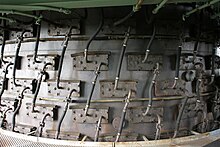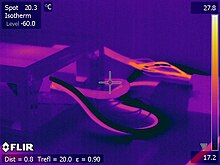Water cooling
A cooling system in which the primarily heat-dissipating coolant is water is referred to as water cooling . Water cooling can be used, for example, to cool a motor , a power plant , a converter , a computer ( PC water cooling ), etc. by means of standing water or an adjacent or continuous water circuit.
Depending on the application, other liquids are used for cooling instead of water:
.
Water cooling in power plants

Two separate cooling circuits are often available for water cooling in modern thermal power plants . These are the mostly open main cooling circuit (also known as the "secondary circuit") and the usually closed secondary cooling water circuit (also known as the "primary circuit").
Example: In a coal-fired power station, the coal combustion in the boiler evaporates the water in the primary circuit, which greatly increases its specific volume. The hot and pressurized steam is then fed to a steam turbine , in which the steam expands and cools. Behind the turbines, so much thermal energy is extracted from the steam at low pressure and temperature in a heat exchanger (“ condenser ”) that it condenses again (becomes liquid). The specific volume is thereby reduced; the water is pumped back into the boiler, the pressure difference is overcome by the feed water pump . In the condenser, the primary circuit steam is cooled with water, which is taken from a nearby body of water - river, lake or sea, less often groundwater. If the withdrawn cooling water after cooling the primary circuit is too warm for a return line to the water, it is cooled down to the required temperature in a cooling tower . Such cooling towers are widespread.
Two cooling circuits make it possible for the closed primary water circuit to contain anti-corrosion agents or for it to be fully demineralized, whereas the additional water in the main cooling water system is at most decarbonised.
Some types of nuclear power plants , such as the pressurized water reactor , have another closed circuit in between. This construction has the advantage that, as a rule, no radioactive substances occur in the second circuit between the steam generator and the turbine. The water in the primary circuit of a nuclear reactor must be free of neutron-absorbing substances such as boron and cadmium .
In the case of the shafts of generators , the heat losses occurring in the two slide bearings are washed around by the supply of approx. 10–20 ° C cold water or the bearing oil is cooled in order to keep the bearing temperature constant at around 50 to 55 ° C. Approximately 25 liters / s and machine are a lower guideline value for a 20 MVA machine at 600 1 / min and of course depending on the machine output. In the case of large generators with an output of 1200 MW, for example, both the generator rotor and the generator stand can be cooled with water. The required cooling water quantities at full load are approx. 120 m³ / h for the rotor and approx. 25 m³ / h for the stand.
Use in combustion engines
Four-stroke engines and diesel two-stroke engines in ships are water-cooled with a few exceptions. Water cooling offers various advantages over air cooling. Water ensures even heat transport and can dissipate a large amount of heat. Hardly any power (auxiliary energy) is required for cooling, compared to cooling fans for air cooling; Liquid cooling can do without any auxiliary energy if the thermosiphon effect ensures sufficient circulation of the cooling medium. The diversion of heat for heating purposes is very easy with a heating heat exchanger. The engine block design and thus the necessary molds are easy to manufacture. The water cooling keeps the temperature difference of individual engine parts and thus the possible delay low. This in turn makes it possible to increase the power density of internal combustion engines . The water jacket also has a soundproofing effect. In particular, high-compression gasoline engines are dependent on water cooling in the area of the cylinder heads , as otherwise the heat of compression would lead to undesirable spontaneous combustion and thus a tendency to knock . Thanks to the high heat transport capacity of water, the motors can be made more compact. In order to increase the boiling point of the coolant, the cooling system is usually operated with overpressure.
Water cooling also has several disadvantages. The coolant can freeze in extreme cold; it will then expand and can burst the radiator or even the engine block. Additional sources of error such as leaks, defects in the water pump, radiator, thermostat, etc. decrease reliability.
The fairway is often used as a coolant in internal combustion engines in watercraft .
Water cooling in devices
Transmitter and power electronics
Since 1930, the tube- equipped power amplifiers of high-power transmitters have been cooled with water. Since high electrical voltages occur here, only distilled or at least deionized water can be used, as it has only a very low electrical conductivity . This gives off its heat in a heat exchanger to a second circuit in which the water does not have to meet any special purity requirements, as it does not come into contact with any live components.
Evaporative condensation cooling is used for high-performance tubes. With this technology, steam generation and condensation are not spatially separated from one another. The coolant flows through the cooling channel, which is equipped with grooves oriented towards the inside of the anode. The steam produced in these grooves gets into the main cooling channel, where it is swirled and condensed again. Since this process takes place at temperatures of over 100 ° C, and the change in the physical state from liquid to gaseous is used, this cooling method can dissipate large amounts of heat even with relatively small tubes because of the necessary heat of vaporization .
Water cooling is also used in power electronics , for example in transmission systems or power converters ( e.g. traction power converters in rail vehicles). Smaller transmitters equipped with semiconductors have no water cooling. In newer transmitters, water cooling is used by some manufacturers for higher outputs from approx. 1 kW.
Large transformers and X-ray machines are cooled with oil .
Converters in HVDC systems often have water cooling. With the mercury vapor valves previously used, this was usually necessary for cooling the cathode; in systems equipped with semiconductors, pure air cooling is possible, but is rarely used. Such systems with oil-cooled converter valves such as the HVDC Volgograd-Donbass and the HVDC Cahora Bassa have also been implemented, but this technology has not caught on.
In hybrid vehicles, there are sometimes two separate water cooling circuits: one for the combustion engine and another for the four-quadrant actuators that control the electric motors and, if necessary, for electronic components that regulate the electricity generated by the motors working as generators for the drive battery during regenerative braking .
Personal computer
Water cooling is also used in modern PC systems for quiet and efficient cooling of individual components. Most often the main processor is cooled. Other components that can be integrated into the cooling circuit, are graphics cards , motherboards chipsets, hard drives , power supplies , voltage converter and RAM building blocks.
Water cooling for PCs is very common in PC modding circles . Meanwhile, a large market for water cooling has emerged.
The advantages of water cooling are, on the one hand, the effective cooling of the hardware with the overclocking range of the CPU, which is important for modders and overclockers, thanks to improved heat dissipation. On the other hand, the cooling works almost silently, as large, slowly rotating fans can be used on the radiator (heat exchanger) or passive radiators without fans can be used. In addition, the reliability and service life of the water-cooled components are usually increased. Depending on the pump used, water cooling can be one of the most energy-efficient cooling methods.
Disadvantages are the considerably greater installation effort, the comparatively high costs and - if the installation is not carried out properly - the maintenance requirement. Often, not using case fans leads to individual components overheating because they are not included in the cooling circuit. Depending on the number of installed components, more space may be required in the housing.
Compared to other liquids in question, water has the highest heat capacity and is therefore the first choice when building a circulating liquid cooling system. In order to avoid possible corrosion problems with the usual mixed metal installation, commercially available antifreeze from the vehicle accessories can be used.
Lasers and lamps
Among other things, the gas discharge lamps for the excitation of solid-state lasers are water-cooled. Together with the laser rod, they are located directly in the deionized cooling water.
High-power diode lasers are also often water-cooled. A distinction is made between active and passive cooling:
- With active water cooling, the water flows in the heat sink directly under the laser bar in micro-channels
- with passive water cooling, only the heat sink carrying the laser submount is water-cooled
High-power carbon dioxide lasers and their mirrors are also often water-cooled:
- Carbon dioxide lasers with a slow longitudinal flow have discharge tubes with a water cooling jacket
- Fast flowing and cross-flowing carbon dioxide lasers have a gas-water heat exchanger in the gas circuit
Other uses
Some examples of water cooling applications are: distillation , blast furnace , laboratory thermostats, high-performance electric motors , plasma jet nozzles, old machine guns , alternators in motor vehicles
See also
- Reflux condenser
- Evaporative cooling
- Thermosiphon cooling
- Heat pipe (heatpipe)
- Deep Lake Water Cooling
- warmth
- Heat capacity of water


